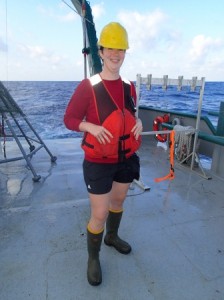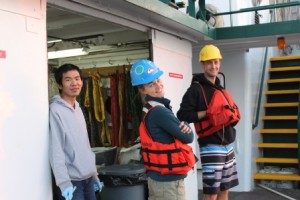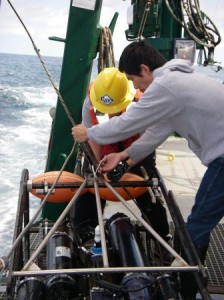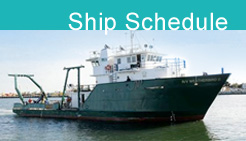Deep Sea Fish and Sediment Surveys in the Gulf
Elizabeth Brown and Bo Yang: USF Graduate Students
Another great part of conducting science research at sea is meeting and working with a number of graduate and undergraduate students. This C-IMAGE cruise we have sailing with us, Elizabeth Brown and Bo Yang from USF College of Marine Science and Matt Flynn from Eckerd College. As well as, Brian Wells and Lee Russell from Florida State University as part of the DEEP-C consortia (see their blog entries). Enjoy these stories about the USF students aboard.
Elizabeth Brown, USF Graduate Student
Hi! I’m Elizabeth. I’m a paleontologist – I’m not the kind who studies dinosaurs (although I love dinosaurs), even if I always get asked that ^^;; I study marine microfossils; tiny creatures the size of a grain of sand, some of them only a single cell, called foraminifera, or “forams” for short. Forams are among the oldest creatures in the evolutionary record. The oldest we’ve found are over a billion years old, and the genus is still going strong today. That’s what makes them so critically important to people like me, who study how the ocean has changed over the ages! Larger, more famous fossil animals, like mastodons, dire wolves, megalodon sharks, pterodactyls , and triceratops are wonderful, but they lived for relatively short periods of time in the big picture of geologic history. It’s like judging a photo album by a single snapshot. Studying how the tiny forams lived & evolved for so long gives us a much broader idea of changing earth, glaciers and oceans.
You know that phrase “You are what you eat?” Well, turns out, that’s true! Forams build their bodies and skeletons, incorporating various nutrients and elements (calcium, magnesium, barium, carbon, oxygen, etc) directly out of the ambient seawater. Their fossil remains are therefore a snapshot of the ocean chemistry at the time the creature was still alive.
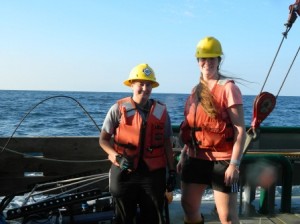
Elizabeth Brown and Karen Dreger successful retrieval of the SIPPER plankton imaging system during C-IMAGE cruise
What’s more, ocean chemistry changesin mathematically predictable ratios with major changes in the environment: major temperature changes, major shifts in salinity, global sea level vs. formation of huge glaciers on land, all kinds of things you’d never think you could see through a fossil plankton (woah!). In short, by breaking down fossil skeletons of tiny forams, analyzing their chemical proportions, and doing a little back-calculating, I can track the evolution of the oceans through the ice ages. How crazy is THAT!?
Bo Yang, USF Marine Science Graduate Student
Bo Yang is a third year graduate student at CMS in Dr. Byrne’s lab. He is working with a team of scientists conducting long term monitoring of the CO2 system in Gulf of Mexico, a research project sponsored by NOAA. His team measures four things in seawater–the pH, carbonate ion concentration, dissolved inorganic carbon (DIC), and total alkalinity (TA). Two measurements must be measured on board because they are very sensitive to interactions with the atmosphere; these are pH and carbonate ion concentrations. Bo uses spectrophotometric methods to measure the pH and carbonate ion concentration soon after the seawater samples arrive onboard from the Niskin bottles. These methods are the most accurate in detecting very small changes in the ocean’s chemistry related to acidification. The dissolved inorganic carbon and total alkalinity are measured on shore on shore in the lab from the water samples collected while at sea.
Bo’s academic timeline
Bo’s name in Chinese means wave and he has spent many days at sea experiencing waves firsthand. For his research he has sailed 130 days at sea including cruises in the East and South China Sea, Gulf of Mexico, Western Atlantic, Northeast Pacific, and Bering Sea. Bo completed his Bachelor’s degree in Xiamen University in China in marine science with a major in marine chemistry and a Master’s degree in environmental chemistry to develop a new technique to measure pH using spectrophotometry. While in China he had read about Dr. Byrne’s research and decided to study abroad for his PhD with Dr. Robert Byrne’s. Visit Dr. Byrne’s at http://www.marine.usf.edu/faculty/robert-byrne.shtml
Why monitor CO2in the ocean?
For Bo’s research the issue is ocean acidification which is a decrease in the pH of seawater. This is a phenomena being observed throughout the global ocean system. Seawater is naturally well buffered with an average pH of 8.2. This constant pH level provides a stable environment for sea life however the chemistry of the ocean is changing so that pH levels are decreasing which causes the ocean to be more acidic. A little change in pH has big impacts on the ocean’s critters, especially those with carbonate shells or other external structures that protect the softer internal parts of the plants and animals. The ocean absorbs about a quarter of the CO2we release into the atmophere every year, so this is a benefit of the ocean absorbing this greenhouse gas. However, as atmospheric CO2 levels increase, so do the levels in the ocean. This is the downside of the CO2 absorbed by the ocean… it is changing the chemistry of the seawater, a process a process called ocean acidification. For some nice educational resources on Ocean Acidification visit NOAA at http://www.pmel.noaa.gov/co2/story/OA+Educational+Tools
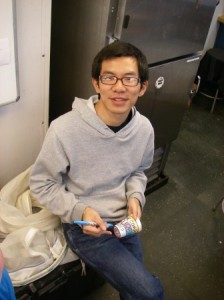
Bo Yang in Long Lab while in transit to first sampling station awaiting first water samples C-IMAGE cruise
| Print article | This entry was posted by greely on February 11, 2013 at 2:09 am, and is filed under Oceanic Updates. Follow any responses to this post through RSS 2.0. You can leave a response or trackback from your own site. |
